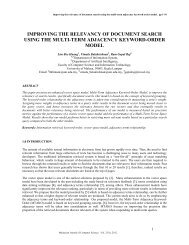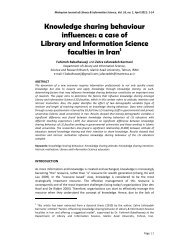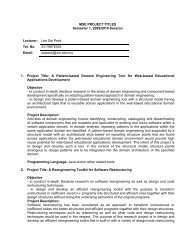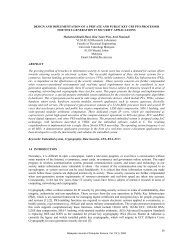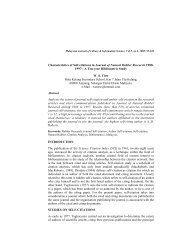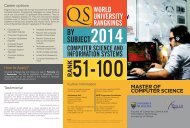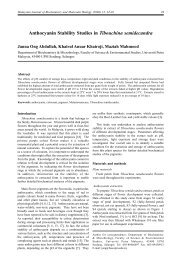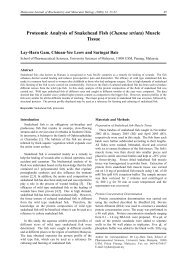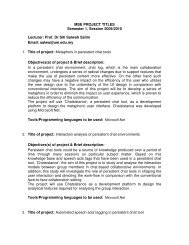46 Annals of Dentistry, University of <strong>Malaya</strong>, Vol. 162009Tooth Brushing Practices and Oral HealthImpacts among Bangladeshi UrbanAdolescents.,I Dr. Md. Tafazzul IslamDepartment of Community DentistryThe aim, of this study was to investigate tooth brushingpractices and oral health related quality. of life(OHRQoL) of adolescents aged 14-15 years oldattending schools in Sylhet city.A cross sectionfll study design was used. Aconvenient sample of 751 respondents aged 14-15 yearold from 6 secondary schools in Sylhet city wererecruited for the study.S-OHIP (M) was used to determine Oral HealthRelated Quality of Life of children. Data collection wasconducted by distributing self administeredquestionnaires among the children.Almost all respondents (95%) brushed their teethusing toothbrush and toothpaste and they owned atoothbrush (98%). Majority (7Q%) of the respondentsbrushed their teeth twice d,aily and used fluoridatedtooth paste (53%). However, about half (42%) of therespondents were unaware whether their toothpastecontained fluoride. Most respondents (95%) learnedhow to clean their mouth and teeth from familymembers. Comm(.lilly reported oral impacts were"toothache" (71%), "felt uncomfortable due"to food, getti.ng'stuck in between teeth or dentures" (66%),)'discomfort during eating any f9od'; '(48%), "d.ifficultyin chewing" (42%) and "concentration bee,n disturbed"(38%). The number of respondents who "very" or."quite often" experienced oral impacts was very smallfor all types of impacts. However, about 11%frequently (very or quite often) experienced toothachewhile 18% were sometimes affected. The associationsbetween frequency of tooth brushing and the following5 oral impacts were' found to be statistically significant:halitosis (p=0.005), sleep disturbed due to problems intheirmouth (p=O.O18)Jeel uncomfortable due to foodimpacted in between their teeth (p=0.025); ulc~rs in themouth (p=0.039), and feeCshy due t~ problems in th.eirmouth (p= 0.047).Most adolescents in Sylhet City clean their teethwith tooth brush and toothpaste. However, many donot know about fluoride toothpaste. Fa!llilies play animportant role in the maintenance of oral hygiene.Tooth ache and oral discomfort were more commonimpacts. Those who brushed at least twice daily wereless likely to have oral impacts compared to those whobrush only once daily.Oral Health Status and impacts amongFirst Year Cadets of National DefenceUniversity MalaysiaDr. Mohd. Rosli MajidDepartment of Community Denstistry ~ ..The aim of the study was to-determine the oral healthl ~status and oral health impacts among UPNM first year.cadets. The objectives of this study were; (1) to assess lthe perceived oral health status, satisfaction with oralhealth and perceived need., for treatment among first.year cadets in UPNM, (2) to assess their level of caries'(DMFS), (3) to assess thei~ level of periodontal disease(CPI) and (4) to assess the oral health impact of oraldiseases in the group by using the Oral Health ImpactProfile (OHIP). This is a cross-sectional survey of theUPNM first yea~. cadets where data was obtainedthrough oral examination (DMFS and CPI) and selfadministered questionnair~ survey (about demographic,perceived oral health, satisfaction with oral health,perceived treatment need and Oral Health Impact).Three hundred and thirty UPNM first year cadets inSg Besi campus were involved in this study.The prevalence of caries free ,and periodontallyhealthy subjects were 40.6% and 5.8% respectively. Themean DMFS was 3.07 of which 16.3% is accounted forby decayed surfaces. Females had higher DMFS thanmales. Nine out of ten cadets had calculus present and16.7% required complex periodontal treatment.Overall, 36.7% of the subjects had often or very oftenexperienced at least one oral health impact due to teeth,mouth, and denture problem. The three OHRQoLdomains most commonly affected were functionallimitation, physical pain and psychological di.scomfort.Social disability had the lowest domain impact amongthe cadets. The impacts which were very often or quiteoften experienced by the subjects were discomfort dueto food getting stuck (24.8%), had ulcer (9.7%) andbad breath (5.8%). Cadets who were free from oraldi~eases (caries and periodontal diseases) had lesseroral health impact. 75.5 % of them perceived theyneeded dental treatment and it significantly related withcaries status and OHRQoL.It is concluded that there is low level of caries, highlevel of periodontal diseases and moderate oral healthimpacts among the cadets. It is recommended thathygienist be stationed in UPNM to assist dentist tomanage the high level oi.periodontal problemsencountered...
Dissertations/Theses 47The effect of abutment angulation onstresses in bone: A 3-dimensional finiteelement studyDr. Muraja Afif UthmanDepartment of Oral and Maxillofacial SurgeryAims: To evaluate the effect of variations in implantabutment angulation on the intensity and distributionof von Mises, tensile and compressive stresses in thebone surrounding an implant using three-dimensional(3-D) Finite Element Method.Methods: 3-D FE models were constructed usingFE software (Pro/Engineer, Wildfire 2.0 parametrictechnology Corporation). The implant fixture was·modeled following Ankylos® system (Dentsply'Friadent, Germany); 3.5 mm in diameter and 11 mmin length, restored with an all-ceramic crownrepresenting the mandibular second premolar. The bonesegment was modeled to approximate the bonedimensions in the region of mandibular secondpremolar. Two situations of implant placement wereinvestigated. Group A represented distal tilting of theimplant in various angulations: 15°, 22.5°, 30° and37.5° and the abutments angled correspondingly so thatthe crown was in similar axial direction. Toaccommodate the abutment, the distal crestal bone was'beveled to level the implant head with the crestal bone.Group B represented a-nother clinical situation, in.which the implant was placed along the long axis ofthe bone while the bone segment was inclined buccallyat various angulations: 15°,22.5°,30° and 37.5°. As inprevious models, corresponding angulated abutmentswere used so that the crown was always loaded insimilar axial position.The control gro~p of this study was a straightimplant and str2:~ght,abutment placed vertically in thece~tre of the hone segment. A 3-D tetrahedral meshwas generated for alt.models constructed. Occlusalloads of 150 N were applied aXIally to the buccal cuspand distal fossa, giving a total load of 300 N for allmodels, to simulate occlusal loading during function.ANSYS versiop 11.0 (ANSYS/Workbench, Ansys Inc,USA) was used to provide the loading simulation andstress pro.file analyses. Results: For the co"ntrol group,stresses (comptessive, tens-ile) were seen concentratedaround the implant collar at the cortical bone. Stresseswere more homogenous in nature surrounding theimplant body and apical area.There was an increase in all types of stressesaround the implant collar in the cortical bone whenincreasing the abutment angulation for both groups.The highest compressive and tensile stresses for theGroup A models were -96 MPa and 60 MJ;>a"respectively, which were observed on the cortical bonearound the implant collar. A high level of compressivestress (-40 MPa) was observed. For the 37S modelwhere the distal cortical bone was cOffi.pletely removedto accommodate the abutment, the Group B modelsshowed -80 MPa and 64.5 MPa for the highestcompressive and tensile stresses respectively.Conclusions: Within the limitations of the presentstudy, the following conclusions were drawn: 1)Stresses appeared to concentrate at the cortical bonearound implant collar for single implant that wasloaded at buccal cusp and distal fossa. The stressesaround the implant body and apical area were relativelylow and homogenous. 2) Stresses increased with-increased abutment angulation for both groups. When37.5° model was used, the stresses increased nearlythree folds. 3) Removal of cortical bone at distal aspectfor 22.5°, 30° and 37.5° models of group A, resultedin high levels of compressive stress at the cancellousbone which may predispose the bone to micro fractureana resorption when they exceed the elastic limit ofbone. 4) Group B, particularly 37.5° model, showedtensile stress higher than the elastic limit of bone,which may undergo microfracture and resorption.Condylar sagittal path angle in selectedMalay females .Ammar Jasim Ali Musawi• Department of Prothetic Dentistry-' .IPURPOSE: To investigate the condylar path angle(CPA) in Malay females, compare the measurementsobtained with the average values (25°-35° Campers)and compare the right condylar path angle with the leftcon-dylar path angle.MATERIALS AND METHODS: A total of thirtysubjects were chosen according to a selected criteria,impressions of arches were made using a washtechnique with silicone regular body over silicone puttytype. Casts were poured into type IV diestone andfacebow transfer was taken for each subject. Casts weremounted to their centric position on Ka Vo Protar evo9 semi-adjustable articulator. Protrusive guides wereconstructed on the anterior teeth of the casts to allowthe mandible to be protruded for 5 mm, then the anglesmeasured using protrusive record method with siliconebite registration material.RESULTS: Within the limitation of this currentstudy, for the right angle it was found that 13 subjects(43.33%) were witltin the range of the average value(25°-35° Campers) and 17 subjects (56.66%) were outof range of the average value. Furthermore, themeasurements for the left angle 10 subjects (33.33%)were found to be in the range of the average value and20 subjects (66.66%) were .out of range. There was nostatistically significant diff~rence 'between the left andright condylar path angles. There was a strong linearrelationship between left and right condylar path anglesamong the Malay females.



